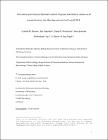| dc.contributor.author | HINTON, JAY | en |
| dc.date.accessioned | 2011-10-05T13:14:53Z | |
| dc.date.available | 2011-10-05T13:14:53Z | |
| dc.date.issued | 2011 | en |
| dc.date.submitted | 2011 | en |
| dc.identifier.citation | Sharma CM, Papenfort K, Pernitzsch SR, Mollenkopf HJ, Hinton JC, Vogel J, Pervasive post-transcriptional control of genes involved in amino acid metabolism by the Hfq-dependent GcvB small RNA., Molecular Microbiology, 81, 5, 2011, 1144 1165 | en |
| dc.identifier.issn | 0950-382X | en |
| dc.identifier.other | Y | en |
| dc.identifier.uri | http://hdl.handle.net/2262/59839 | |
| dc.description | PUBLISHED | en |
| dc.description.abstract | GcvB is one of the most highly conserved Hfq-associated small RNAs in Gram-negative bacteria and was previously reported to repress several ABC transporters for amino acids. To determine the full extent of GcvB-mediated regulation in Salmonella, we combined a genome-wide experimental approach with biocomputational target prediction. Comparative pulse expression of wild-type versus mutant sRNA variants revealed that GcvB governs a large post-transcriptional regulon, impacting ~1% of all Salmonella genes via its conserved G/U-rich domain R1. Complementary predictions of C/A-rich binding sites in mRNAs and gfp reporter fusion experiments increased the number of validated GcvB targets to more than twenty, and doubled the number of regulated amino acid transporters. Unlike the previously described targeting via the single R1 domain, GcvB represses the glycine transporter CycA by exceptionally redundant base-pairing. This novel ability of GcvB is focused upon the one target that could feedback-regulate the glycine-responsive synthesis of GcvB. Several newly discovered mRNA targets involved in amino acid metabolism, including global regulator Lrp, question the previous assumption that GcvB simply acts to limit unnecessary amino acid uptake. Rather, GcvB rewires primary transcriptional control circuits and seems to act as a distinct regulatory node in amino acid metabolism. | en |
| dc.description.sponsorship | We thank Karsten Hokamp for designing the SALSIFY microarray, and Franziska Seifert and
Ina Wagner for technical assistance. We are grateful to Sacha Lucchini for help at an early
stage of this project. J.C.D.H. was supported by a Principal Investigator award (reference
08/IN.1/B2104) from Science Foundation Ireland. The Vogel lab was supported by the DFG
(German Research Council) Priority Program SPP1258 Sensory and Regulatory RNAs in
Prokaryotes SPP1258, Vo875/3?1, and BMBF (German Ministry of Education & Research)
grant 01GS0806/JV?BMBF?01. | en |
| dc.format.extent | 1144-1165 | en |
| dc.language.iso | en | en |
| dc.relation.ispartofseries | Molecular Microbiology | en |
| dc.relation.ispartofseries | 81 | en |
| dc.relation.ispartofseries | 5 | en |
| dc.rights | Y | en |
| dc.subject | Immunology | en |
| dc.subject | Biochemistry | en |
| dc.subject | small RNA | en |
| dc.title | Pervasive post-transcriptional control of genes involved in amino acid metabolism by the Hfq-dependent GcvB small RNA. | en |
| dc.type | Journal Article | en |
| dc.type.supercollection | scholarly_publications | en |
| dc.type.supercollection | refereed_publications | en |
| dc.identifier.peoplefinderurl | http://people.tcd.ie/hintonj | en |
| dc.identifier.rssinternalid | 73873 | en |
| dc.identifier.doi | http://dx.doi.org/10.1111/j.1365-2958.2011.07751.x | en |
| dc.subject.TCDTheme | Immunology, Inflammation & Infection | en |
| dc.identifier.rssuri | http://dx.doi.org/10.1111/j.1365-2958.2011.07751.x | en |
| dc.contributor.sponsor | Science Foundation Ireland (SFI) | en |
| dc.contributor.sponsorGrantNumber | 08/IN.1/B2104 | en |




